Use 'Print preview' to check the number of pages and printer settings.
Print functionality varies between browsers.
Printable page generated Saturday, 20 April 2024, 12:03 AM
Communicable Diseases Module: 33. Bacterial and Viral Faeco-Oral Diseases
Study Session 33 Bacterial and Viral Faeco-Oral Diseases
Introduction
In the previous study session you learnt about the general features of faeco-oral diseases. With that introduction in mind, we will now discuss the common faeco-oral diseases caused by bacteria and viruses. In Study Session 34, you will learn about faeco-oral diseases caused by protozoa and intestinal worms. The conditions covered in this study session are divided into two groups: bacterial and viral faeco-oral diseases characterised by diarrhoea, and those characterised by high fever.
We begin with three diarrhoeal diseases: cholera, shigellosis and rotavirus infections. In each case, you will learn about their specific infectious agents, occurrence, modes of transmission, symptoms and signs. Then we remind you of the common features of the diagnosis and treatment, prevention and control of diarrhoeal diseases, which you already studied in general terms in Study Session 32. Finally, we describe the febrile illness, typhoid fever, which is also transmitted by the faeco-oral route. The focus of discussion in this study session will be on aspects that will be especially important to you in your daily work as a Health Extension Practitioner.
Learning Outcomes for Study Session 33
When you have studied this session, you should be able to:
33.1 Define and use correctly all of the key words printed in bold. (SAQs 33.1, 33.2 and 33.4)
33.2 Describe the most common types of bacterial and viral faeco-oral diseases, their causative infectious agents and their occurrence in the population. (SAQs 33.1 and 33.3)
33.3 Describe the main modes of transmission of each of the bacterial and viral faeco-oral diseases, and the age groups that are most susceptible to them. (SAQs 33.3 and 33.4)
33.4 Explain how you would diagnose and treat cases of bacterial and viral faeco-oral diseases, and when and why you would refer them to a higher-level health facility. (SAQs 33.2 and 33.4)
33.5 Describe how you would apply prevention and control measures against bacterial and viral faeco-oral diseases, and what actions you would take to prevent epidemics of cholera or shigellosis. (SAQs 33.2 and 33.4)
33.1 Cholera
We begin by discussing cholera – its infectious agent, occurrence, symptoms and signs. Knowing about the nature of cholera will help you to diagnose, treat, prevent and control this disease, as described in Sections 33.5 and 33.6, together with measures against all the other bacterial and viral diarrhoeal diseases.
33.1.1 Infectious agents and occurrence of cholera
What comes to your mind when hear the word cholera? It is an acute diarrhoeal disease that affects the intestines and can kill vulnerable patients within a few hours if they are not treated quickly. The WHO estimates that there are 3 to 5 million cases of cholera every year around the world, and between 100,000 to 120,000 deaths. It can affect people in all age-groups. Cholera is caused by the bacteria named Vibrio cholerae (Figure 33.1), which occur naturally in the environment in shallow water around coasts, particularly where rivers flow into the sea. However, people infected by cholera bacteria can rapidly spread the organisms anywhere in a country, particularly where faeces leak into waste water collections.
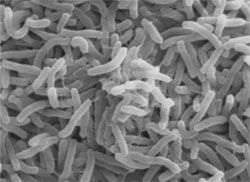
33.1.2 Cholera epidemics
Cholera can spread very easily from person to person, because even a few bacteria are enough to cause the disease if the person is already vulnerable, e.g. due to malnutrition or other infections. Although about 75% of people infected with the bacteria do not develop any symptoms, they can still pass on the infection in their faeces for up to two weeks, so epidemics can develop very quickly.
Do you remember the definition of an epidemic? (Think back to Study Session 1 in Part 1 of this Module.)
An epidemic is defined as a sudden rise in the number of cases of a condition, which go on increasing for weeks or months before being brought under control; sometimes the numbers affected in an epidemic can continue rising for years (e.g. HIV/AIDS).
There have been epidemics of cholera in Ethiopia; in 1970, several thousand deaths occurred in the eastern, central and southern regions of the country. Conditions leading to epidemics include the consumption of unsafe water, poor hygiene, poor sanitation and crowded living conditions. Cholera often follows after natural disasters involving flooding, and when large numbers of refugees live in camps (Figure 33.2). Consideration of these factors is important for the prevention and control of epidemics of cholera. In Section 35.2 of this study session, we mention the actions that should be taken to prevent a single case from leading to an epidemic. The details of epidemic investigations and management more generally are the subject of Study Session 42.
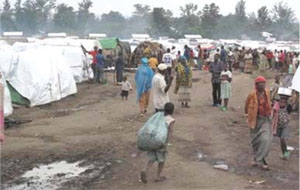
33.1.3 Symptoms and signs of cholera
Knowledge of the typical symptoms and signs of cholera will help you to suspect cases and undertake further epidemic investigation measures. Cholera usually manifests after an incubation period of one to five days (i.e. the time between the bacteria entering the person’s body and the first symptoms appearing), but it can begin within a few hours after the infection. In about 80% of cases, the disease presents with relatively mild symptoms, but about 20% develop acute watery diarrhoea with severe sudden onset. The stools are painless and voluminous, with the appearance of water in which rice has been boiled (rice-water stools are a characteristic sign of cholera). The patient also experiences nausea, vomiting (Figure 33.3), fever and rapid progression to experiencing extreme weakness and shock. In such cases, death may occur within hours after the start of the illness.
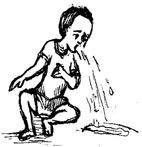
Shock in cholera results from rapid dehydration and loss of essential salts in the voluminous diarrhoea and vomit. You learned about shock as a result of haemorrhage during and after childbirth in the Modules on Labour and Delivery Care and Postnatal Care. The signs are the same in shock due to severe dehydration caused by cholera.
What are the typical signs of shock in an adult patient?
The typical signs of shock are systolic blood pressure dropping below 90 mmHg and/or diastolic blood pressure dropping below 60 mmHg, with a rapid pulse rate above 100 beats per minute. A person in shock will often appear confused and may lose consciousness. You must act quickly to save their life.
If you see a person with the characteristic symptoms and signs of cholera, you must manage the patient immediately and begin effective control measures in the community (as described below in Sections 33.4 and 33.5). The risk of a cholera epidemic developing from a single case is high, so you must also undertake epidemic investigation and management procedures, which will be described for all epidemic conditions in Study Session 42.
Suppose you were called to see an adult with acute watery diarrhoea and profuse vomiting of two days’ duration. What other evidence would suggest a diagnosis of cholera in this person?
In addition to the rapid onset and progression of the illness, the following symptoms and signs would support the diagnosis of cholera:
- Painless diarrhoea and rice-water appearance of his stool
- Fever
- Extreme weakness
- Shock (low blood pressure and rapid pulse rate)
- Similar cases in the household or nearby.
33.2 Shigellosis (or bacillary dysentery)
The word dysentery refers to diarrhoea containing blood and mucus. There are two main types of dysentery, caused by different infectious agents. The one that we are going to describe here is bacillary dysentery, or shigellosis. The other type is amoebic dysentery, which is discussed in Study Session 34. However, in this section we will mention some of the main differences between the two types of dysentery, to help you diagnose them correctly.
33.2.1 Infectious agents and occurrence of shigellosis
The infectious agents causing shigellosis are different species of Shigella bacteria. Although these bacteria may cause mild cases of acute watery diarrhoea, dysentery is the real threat in shigellosis. The bacteria infect and destroy cells lining the patient’s large intestine (colon), causing ulcers and bleeding, which results in the characteristic appearance of blood and mucus in the stool.
As you may recall from Study Session 1 of this Module, dysentery is common in Ethiopia, ranking among the top ten causes of outpatient visits (refer to Table 1.1). Although Shigella infection can occur at any age, it is rare in infants less than six months of age and most common in children aged two to three years. This age-distribution is unlike amoebic dysentery, which is rare in children less than five years of age. Two-thirds of the cases of shigellosis and most of the deaths are in children below ten years, and (like all diarrhoeal diseases) the effects are most severe in malnourished children.
Shigella bacteria can be easily transmitted from person to person and rapidly cause epidemics, particularly under conditions of overcrowding, where personal hygiene is poor, such as in prisons, institutions for children, and refugee camps. Small doses of the infectious agent – as few as ten organisms – are enough to transmit the infection, which means it can be transmitted easily to close contacts. Another reason for the rapid spread is that after recovery, infected individuals can transmit the bacteria in their faeces for up to four weeks after the illness. By contrast, epidemics of amoebic dysentery rarely occur. Therefore, if an epidemic of dysentery occurs in your community, you should suspect the most likely cause is bacillary dysentery due to Shigella bacteria.
33.2.2 Symptoms and signs of shigellosis
Symptoms of shigellosis usually appear after an incubation period of one to three days. The diarrhoea may be watery and of a large volume initially, but then changing into frequent, small-volume episodes of bloody and mucoid (mucus-containing) diarrhoea. The onset of the disease is sudden, with fever, abdominal pains, straining during defaecation and an irresistible urge to defaecate, but only small quantities of blood and mucus come out, without any formed solid stools. The person may complain of abdominal cramps and pain in the rectum, and is often too ill to leave their bed. Dehydration can progress quickly and may lead to shock and death if not rapidly treated.
33.3 Rotavirus infection and other viral diarrhoeal diseases
In this section, we will briefly mention the viruses that cause diarrhoeal diseases. The most prevalent infectious agents in this category are the rotaviruses. The WHO estimates that about 40% of all cases of severe infant diarrhoea worldwide, and at least 500,000 deaths in childhood from diarrhoeal diseases, are due to rotavirus infections – making these viruses the single biggest cause of diarrhoeal deaths. Most cases occur between the ages of three months and two years. Other viruses responsible for diarrhoeal diseases include the noroviruses.
The main manifestations of viral diarrhoeal diseases include acute, very watery diarrhoea, nausea and projectile vomiting, often (but not always) with fever and abdominal pain. Vomiting is called ‘projectile’ when the person cannot control the rapid emergence of vomit, which is projected forwards from the mouth with great force. Dehydration can occur rapidly in children and is the most common cause of death.
Individuals at highest risk from viral diarrhoeal diseases are malnourished children, weanlings and bottle-fed infants. To help prevent rotavirus infections, encourage exclusive breastfeeding under the age of six months; if the mother cannot breastfeed, or after weaning, encourage feeding with a very clean cup and spoon instead of a bottle. If bottles have to be used, show the parents how to wash the bottles and teats frequently and very thoroughly with clean warm water and soap.
33.4 Modes of transmission of diarrhoeal diseases
All three types of diarrhoeal diseases discussed so far are transmitted directly or indirectly by faeco-oral routes, as already described in detail in Study Session 32.
Briefly distinguish between direct and indirect modes of faeco-oral transmission of infectious agents.
Direct transmission occurs through contact between hands contaminated with faeces and the person’s mouth; indirect modes of transmission are through ingestion of contaminated food or water, contact with infected soil, utensils, etc., and transmission by flies that have crawled on faeces (Figure 33.4).
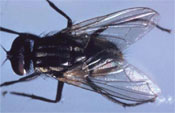 Figure 33.4 Flies are a major source of indirect transmission of diarrhoeal diseases. (Photo: CDC Image Library, image 5452)
Figure 33.4 Flies are a major source of indirect transmission of diarrhoeal diseases. (Photo: CDC Image Library, image 5452)
The main modes of transmission for cholera, shigellosis and viral diarrhoeal diseases are summarised in Table 33.1 and Figure 33.5.
| Diarrhoeal disease | Main modes of transmission |
|---|---|
| Cholera | Contaminated water or food (summarised in Figure 33.5) |
| Shigellosis (bacillary dysentery) | Person-to-person contact, e.g. while caring for a sick person, or via contaminated water or food |
| Viral diarrhoeal diseases | Contaminated water or food, particularly when feeding infants with milk or other nutritious fluids in a contaminated bottle |
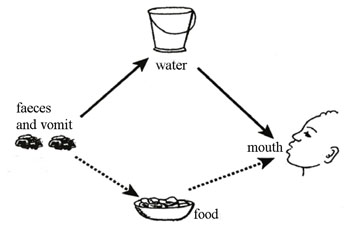
33.5 Diagnosis, treatment and control of bacterial and viral diarrhoeal diseases
You have already learned the general features of the diagnosis and treatment of diarrhoeal diseases in Study Session 32, so the discussion below will remind you of the main points in your role as a Health Extension Practitioner.
33.5.1 Diagnosis of diarrhoeal diseases
Accurate diagnosis of a specific type of diarrhoeal disease is only possible with laboratory identification of the infectious agents, mainly from stool samples. This can be essential in determining the type of treatment if antibiotics are required, and can also help to target prevention and control measures most effectively. However, laboratory diagnosis of the infectious agent takes time and is not needed for the treatment of most cases of acute watery diarrhoea among children. You can begin treating most children immediately on the basis of your clinical diagnosis, i.e. your knowledge of the characteristic symptoms and signs of acute watery diarrhoea described earlier in this study session, without the need for identifying the specific infectious agent.
Laboratory diagnosis is required for:
- children with dysentery (which could be bacillary or amoebic)
- all adults with severe diarrhoea, however caused.
Even in cases where laboratory diagnosis is required, you should not wait for the results of the investigation before starting rehydration as described below (Section 34.4.2) and referring the patient to the nearest health centre or hospital. Explain to the adult patient or caregiver (if the patient is a child) that referral is needed for further diagnosis, because treatment varies depending on the specific cause of the disease. Ensure that the patient seeks treatment urgently, as the disease could worsen rapidly and lead to serious outcomes.
Although you can’t be sure of the diagnosis yourself, if you suspect dysentery or cholera, ask whether anyone else in the patient’s household, or their neighbours, have a similar illness. This helps you to identify and report suspected cases, which is essential to prevent an epidemic from spreading.
33.5.2 Treatment of bacterial and viral diarrhoeal diseases
As you already know, for all patients with diarrhoea (watery or bloody), the core measure in treatment of all cases is rapid and adequate rehydration – fluid replacement. This is usually achieved by the patient drinking plenty of fluids, but in the most severe cases the fluid has to be given intravenously (directly into a vein). Rehydration should be started as soon as possible and continued for as long as the diarrhoea persists. The best fluid to prevent or treat dehydration is a solution of oral rehydration salts (ORS) – a simple mixture of sugar and salts in the correct proportions mixed with boiled and cooled water (Figure 33.6).
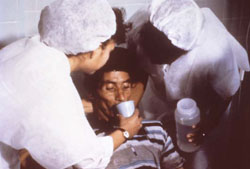
In addition to rehydration, other interventions might also be necessary depending on the type of disease and the age of the patient. For children with diarrhoea, the measures that you should undertake during treatment were summarised in Box 32.1 in the previous study session. However, before you can treat a child with diarrhoea correctly, you first need to learn how to assess and classify the danger signs and the level of dehydration; this is taught in detail in the Module on the Integrated Management of Newborn and Childhood Illness (IMNCI) in this curriculum.
![]() A patient in shock due to severe diarrhoeal disease will die without adequate and rapid rehydration.
A patient in shock due to severe diarrhoeal disease will die without adequate and rapid rehydration.
For adults with severe diarrhoea, assess if the patient is able to take fluids orally. If they are too weak or nauseous to take fluids orally, or they are showing signs of shock, refer them immediately to the nearest health centre or hospital. Advise the patient or caregiver that immediate treatment is necessary to save the patient’s life.
If the patient is able to take fluids orally, give ORS and tell them to drink 200–400 ml of ORS after each loose stool. Advise the patient to drink other fluids as much as possible and to continue eating. Adults with severe diarrhoea due to bacteria may also need an antibiotic treatment appropriate for the specific disease, after first determining the type of bacteria from laboratory examination of a stool sample. This is one reason why adults with severe diarrhoea are given ORS and referred to a higher health facility.
33.6 Prevention and control of bacterial and viral diarrhoeal diseases
Prevention and control measures for all diarrhoeal diseases, whatever the infectious organism, aim at interrupting faeco-oral transmission from contaminated hands, water, food and other sources. Look back at Study Session 32 to remind yourself of the key points to emphasise when you educate people in your community on how to protect themselves and their children from developing diarrhoeal diseases. Figure 33.7 illustrates some important strategies that everyone should know.

33.6.1 Controlling epidemics of diarrhoeal diseases
What else should you do if there is an outbreak of a diarrhoeal disease, which threatens to spread in the community?
Which bacterial or viral diarrhoeal diseases are most often associated with epidemics? Do you remember two reasons why?
Cholera and shigellosis (bacillary dysentery) can rapidly spread and cause an epidemic. The two main reasons are that very small numbers of bacteria (fewer than ten) can result in the illness if they get into a susceptible person, and people who have recovered from the illness can go on shedding the bacteria in their faeces for weeks afterwards.
![]() Suspected cases of cholera or shigellosis (bacillary dysentery) should be immediately reported to the woreda Health Office.
Suspected cases of cholera or shigellosis (bacillary dysentery) should be immediately reported to the woreda Health Office.
Whenever you suspect there may be a single case of cholera or shigellosis in your community, you must take swift action to investigate and report it, and apply measures to control the source of infection before it can spread. Epidemic investigation techniques will be discussed in detail in Study Session 42, so here we will briefly summarise the main points.
Why do you think it is important to report suspected cases of cholera or shigellosis to the woreda (District) Health Office?
You cannot prevent an epidemic from developing on your own. Reporting suspected cases enables the woreda Health Office and other higher bodies to start epidemic investigation and laboratory diagnosis as soon as possible, and collaborate with you in taking action to control the outbreak before it spreads.
You should try to identify everyone who has been in close contact with the source patient (i.e. the first case in your community) by asking the patient, the family and neighbours about what the patient has been doing recently and who he or she has seen. It is particularly important to locate everyone who has been eating the same food or drinking water from the same place as the patient. Give these individuals advice to seek early treatment if the illness starts and to report it immediately.
33.6.2 Epidemic control measures for cholera
In addition to the points described above, you should take action to prevent the spread of cholera bacteria in water, food or on the hands of people who have been caring for patients.
- Ensure that everyone in contact with the patient knows that they must be especially careful to wash their hands very thoroughly with soap and water after touching the patient, as well as at all the usual times (after defaecation, before preparing food or eating, etc.)
- Make sure that faeces or vomit from the patient cannot contaminate sources of drinking water, for example, when washing the patient’s soiled clothes, bedding or drinking cups. Do not wash any articles that may be carrying cholera bacteria in streams, pools or water containers that people use to collect drinking water (Figure 33.8). Infected water is one of the main transmission modes for cholera bacteria. In a cholera epidemic, everyone in the community must use protected water sources for drinking, and either boil the water or disinfect it by adding chlorine.
- Disinfection of clothes contaminated with faeces and vomit, and articles used by patients, is essential; they should be boiled or scrubbed with a disinfectant solution such as chlorine bleach.
- Interruption of foodborne transmission includes cooking food thoroughly before eating, preventing contamination of food by flies and avoiding eating raw vegetables and fruits.
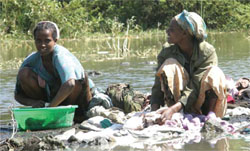
33.6.3 Epidemic control measures for shigellosis
Shigella bacteria are particularly likely to be passed directly from one person to another, for example when shaking hands, so people who are caring for a patient with bacillary dysentery are at high risk of infection. Educate carers that a very small number of organisms can cause infection and that strict hygiene precautions are needed when handling the faeces of patients. In addition, patients and carers should understand that anyone with a Shigella infection should not prepare food for others to eat, or care for a young child or a sick person, until a month after recovery. This is because the bacteria continue to be shed from the person in their faeces for several weeks, and can easily be transmitted to vulnerable contacts.
What measures would be most important in preventing transmission of shigellosis?
The measures to be given priority include:
- frequent and very thorough handwashing with soap and water (Figure 33.9)
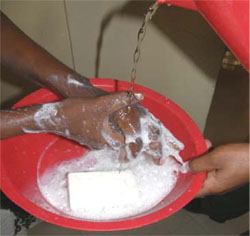 Figure 33.9 Handwashing with soap and water is the single most important measure to control a shigellosis epidemic. (Photo: Basiro Davey)
Figure 33.9 Handwashing with soap and water is the single most important measure to control a shigellosis epidemic. (Photo: Basiro Davey)- avoiding direct contact with faeces if possible, and disposing of faeces safely
- disinfection of clothing and articles contaminated with faeces.
33.6 Typhoid fever
In the final section of this study session, we turn to typhoid fever – a bacterial faeco-oral disease caused by Salmonella typhi bacteria, which is classified as a febrile illness (not a diarrhoeal disease). The incubation period is usually one to two weeks. Although typhoid fever can cause diarrhoea in children, it is rare in children of less than five years of age. In adults, diarrhoea may be present in the early stage of the illness, but this quickly turns to constipation. The main distinguishing feature is a very high fever (39oC to 40oC), with headache, lethargy, loss of appetite, and sometimes rose-coloured spots on the chest. If you are trained to palpate the abdomen, you may be able to feel an enlarged liver and spleen.
Typhoid fever is a major health problem in poor communities and is endemic (always present at a relatively constant rate) in Ethiopia. The WHO estimates that there are about 17 million cases worldwide every year. Transmission of typhoid fever can occur by the direct faeco-oral route, but it is mainly transmitted indirectly through contaminated water and food.
What other febrile diseases have you learned about so far in this Module, i.e. with high fever as one of their main manifestations?
Malaria and meningococcal meningitis are febrile diseases. (In Study Session 36, you will learn about two more: louse-borne relapsing fever and typhus.)
You can suspect a case of typhoid fever based on your clinical diagnosis, but because the symptoms of typhoid fever are similar to that of malaria, you should first use the malaria rapid diagnostic test (RDT) if you are in an area where malaria is endemic (Figure 33.10). Even after ruling out malaria, you can’t be sure of the diagnosis of typhoid fever, because meningitis and relapsing fever can also present with similar symptoms and signs. Therefore, if you suspect typhoid fever, refer the patient to the nearest higher level health facility for laboratory diagnosis and specialist treatment.
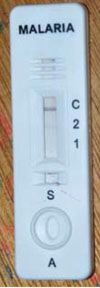
As with other faeco-oral diseases, your role in the prevention and control of typhoid fever is giving health education to your community on measures that aim to interrupt faeco-oral transmission. In the next study session, we will focus on faeco-oral diseases caused by single-celled parasites and helminths (worms).
Summary of Study Session 33
In Study Session 33, you have learned that:
- Common faeco-orally transmitted diseases caused by bacteria and viruses include cholera, shigellosis (bacillary dysentery), viral diarrhoeal diseases (rotavirus infection is the most prevalent), and typhoid fever.
- Cholera is a bacterial disease, which manifests with painless, acute watery diarrhoea that resembles rice-water, and profuse vomiting.
- Shigellosis or bacillary dysentery is an acute diarrhoeal disease characterised by blood and mucus in the stool, with urgency and straining during defaecation.
- Viral diarrhoeal diseases are the commonest type of diarrhoeal disease, particularly in children. Their manifestation is mainly acute watery diarrhoea.
- The transmission of cholera bacteria and rotaviruses is mainly via contaminated water and food, whereas shigellosis is mainly spread via person-to-person contact.
- Cholera and shigellosis are prone to epidemics, because small numbers of bacteria can cause the illness, and bacteria continue to be shed for some time after the patient recovers.
- Epidemic control measures include swift case reporting, identification of contacts of the source patient, frequent thorough handwashing with soap and water, safe disposal of faeces, and disinfection or boiling of clothes, bedding and utensils used by the patient.
- You can treat most cases of children with acute water diarrhoea at Health Post level, without the need for laboratory diagnosis of the causative infectious agent. However, adults with severe diarrhoea and children with dysentery should be referred urgently after starting rehydration with oral rehydration salts (ORS).
- Typhoid fever is a febrile illness, characterised by high continuous fever, with constipation (rather than diarrhoea) in most adult patients. The disease is spread faeco-orally via infected water and contaminated food. If you suspect typhoid fever, you should refer the patient quickly.
Self-Assessment Questions (SAQs) for Study Session 33
Now that you have completed this study session, you can assess how well you have achieved its Learning Outcomes by answering the questions below. One question also tests some of the Learning Outcomes of Study Session 32. Write your answers in your Study Diary and discuss them with your Tutor at the next Study Support Meeting. You can check your answers with the Notes on the Self-Assessment Questions at the end of this Module.
SAQ 33.1 (tests Learning Outcomes 33.1, 31.2, 31.3 and 33.4)
Which of the following statements is false? In each case, state why it is incorrect.
A Typhoid fever is transmitted mainly indirectly by contaminated food or water.
B The characteristic manifestations of cholera include bloody diarrhoea.
C Shigellosis is transmitted mainly by direct person-to-person contact.
D Diarrhoeal diseases can lead to severe dehydration and shock.
E Viruses are the commonest cause of diarrhoea in children.
F Typhoid fever is a common cause of diarrhoea in adults.
Answer
A is true. Typhoid fever is transmitted mainly indirectly, via contaminated food or water.
B is false. The characteristic manifestations of cholera are voluminous rice-water diarrhoea and vomiting – but not bloody diarrhoea.
C is true. Shigellosis is transmitted mainly by direct person-to-person contact.
D is true. Diarrhoeal diseases can lead to severe dehydration and shock.
E is true. Viruses are the commonest cause of diarrhoea in children.
F is false. Typhoid fever usually presents with constipation rather than diarrhoea in adults. The main symptom is continuous high fever.
SAQ 33.2 (tests Learning Outcomes 31.1, 33.4 and 33.5)
If you see an adult patient with bloody diarrhoea, what actions should you take:
- a.To treat the patient?
- b.To prevent the disease from spreading?
Answer
- a.In an adult patient with bloody diarrhoea, you should start immediate rehydration with ORS, and refer him/her to a higher health facility for laboratory diagnosis of the causative infectious agent and specific treatment.
- b.You should report the suspected case to the woreda Health Office and request assistance in preventing an epidemic. Ask the patient’s family members and neighbours about the presence of other individuals with a similar illness, and advise all contacts of the patient to apply thorough hygiene measures, including handwashing with soap and water. Make sure they control the spread of the infectious agents by boiling or disinfecting clothes, bedding or utensils used by the patient; these articles must not be washed in water sources used for bathing or drinking.
SAQ 33.3 (tests Learning Outcomes 33.2, 33.3 and 33.4)
Complete the missing details from Table 33.3 below.
| Disease | Incubation period | Age group for most cases |
|---|---|---|
| Cholera | ||
| Shigellosis | ||
| Rotavirus infection | ||
| Typhoid fever |
Answer
The completed version of Table 33.3 appears below.
| Disease | Incubation period | Age group for most cases |
|---|---|---|
| Cholera | 2 hours to 5 days | All ages can be affected |
| Shigellosis | 1 to 3 days | 2 to 3 years |
| Rotavirus infection | 2 to 3 days | Under 5 years |
| Typhoid fever | 1 to 2 weeks | Over 5 years |
SAQ 33.4 (tests Learning Outcomes 33.1, 33.2, 33.2, 33.4 and 33.5)
- a.Rotaviruses are endemic in all developing countries and the major cause of diarrhoeal diseases in young children. What does endemic mean?
- b.How are bacterial and viral diarrhoeal diseases transmitted?
- c.A nine-month-old baby has had three episodes of watery diarrhoea in the last three days. The mother says the child is still partly breastfed, and is eating and drinking normally. It does not appear to be dehydrated. What actions should you take and what should you advise the mother?
Answer
- a.Endemic means that rotaviruses and the diarrhoeal diseases they cause are ‘always present’ in the country at an approximately steady rate.
- b.Bacterial and viral diarrhoeal diseases are transmitted directly by hands contaminated with faeces that make contact with the mouth, and indirectly in contaminated food, water, soil and utensils (e.g. bottles used to feed milk to infants), and by flies that have crawled over faeces.
- c.The mother tells you that the infant is still breastfeeding, eating and drinking normally. As long as it is not dehydrated, there is no need to give ORS immediately. But the mother should be advised to go on breastfeeding as much as the child will drink, and feed other nourishing food and drinks with a very clean cup and spoon. She should wash her hands frequently and thoroughly with soap, particularly after changing the infant’s nappy (diaper) or cleaning its bottom. Tell her she must bring the child back to see you immediately, or take it to the nearest health centre or hospital, if its diarrhoea persists or gets worse.